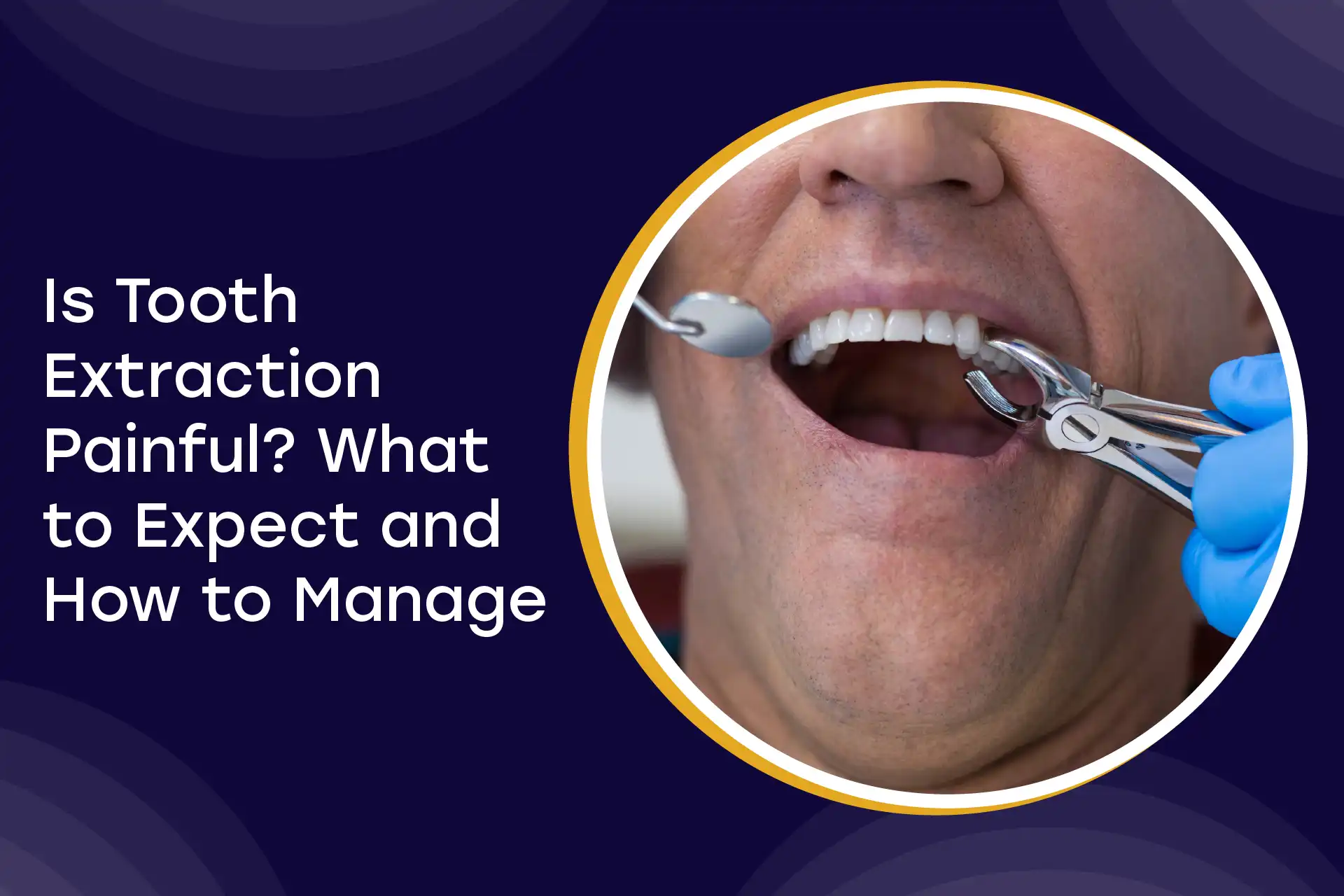Tooth extraction may make people anxious, leading to avoidance of dental care. Other fears, such as infections, dry sockets, and prolonged soreness, make the procedure more intimidating than it typically is. Understanding the different processes involved and implementing the necessary pain management techniques, makes it possible to approach tooth extraction with greater confidence, minimise the associated discomfort, and even ensure a painless tooth extraction. This blog aims to provide information on the ins and outs of tooth extraction and effective strategies for managing discomfort.
A] Understanding Tooth Extraction
Understanding the procedure of tooth extraction can help patients relax. Tooth extraction involves removing a tooth from its root. Removal may be necessary primarily due to dental issues like tooth decay, overcrowding, or third molars.
Tooth extraction can be of two types: Simple and surgical. The former is performed on visible teeth that can be easily loosened and removed using specialised instruments, while the latter is more complex and may require additional procedures such as bone removal or suturing.
B] Pain During Tooth Extraction
Understanding the role of anaesthesia is crucial in managing your worries about tooth extraction pain. Anaesthesia is the most important factor in managing pain during a tooth extraction, ensuring the procedure is as comfortable as possible. It reduces the pain by blocking pain signals from reaching the brain, allowing for a comfortable and painless extraction experience. Patients can find the top experts for oral surgery in Wadala to ensure that their anaesthesia and the rest of the process are done right.
There are three types of anaesthesia commonly used which are –
- Local anaesthesia: It is often used for simple extractions. Patients generally feel a brief pinch when the injection is administered, and the area around the tooth becomes numb.
- Sedation: This involves administering a sedative medication to relax the patient and reduce anxiety. Sedation can be either conscious or deep. Patients often have little memory of the procedure; they feel calm and relaxed during it, as it reduces anxiety and fear associated with dental procedures.
- General anaesthesia: It involves putting the patient into a deep sleep, eliminating pain and awareness, and ensuring a painless extraction process. In short, the anaesthesia varies depending on the complexity of the procedure.
Overall, anaesthesia aims to ensure that patients experience minimal pain and discomfort during tooth extraction. By understanding the different types of anaesthesia and how they work, patients can make informed decisions about their care.
C] Pain After Tooth Extraction
It is common to experience some pain and discomfort after a tooth extraction. This is a normal part of the healing process. The severity and duration can vary depending on several factors. Typically, patients will experience mild to moderate discomfort once the anaesthesia wears off. This discomfort usually peaks within the first 24 to 48 hours and gradually decreases as the extraction site begins to heal.
Factors That Influence Pain Levels
Several factors can influence the level of pain. Some of them are-
- Different people have different pain thresholds, and their experiences with pain may vary.
- Another factor is the complexity of the extraction. Surgical tooth extractions or those involving impacted teeth may result in more significant pain and discomfort compared to simple extractions.
- As with any post-surgery instruction, following the dentist’s recommendations for post-operative care can help minimise pain and promote healing.
The duration of pain after tooth extraction can vary from a few days to a week.
In general, post-extraction pain typically lasts for about 3 to 5 days. Mild discomfort could persist for up to a week or more for more complex extractions. If the pain persists or intensifies, it is important to contact your dentist for evaluation.
D] How to Manage Pain After Extraction
Managing tooth removal pain is crucial for comfort and quicker recovery. There are various pain relief methods through which an individual copes with it. Let’s understand them:
- Medications
Your dentist usually prescribes medications to help manage discomfort after the extraction. These can either be over-the-counter pills like Ibuprofen (Advil) or acetaminophen (Tylenol) or prescribed medications like opioids (codeine or hydrocodone). Antibiotics are also another form of medication. One must follow caution and take medication through his/her doctor.
- Cold Compresses
This method is used in every household for all kinds of wounds, swellings, and sprains. Applying a cold compress or ice pack helps reduce the swelling and numbness near the affected area. The compress must be applied for 10-20 minutes, with breaks in between.
- Rest
This is the most basic but necessary method for healing any kind of wound or swelling. Getting adequate rest can help your body heal more efficiently.
What to Avoid to Reduce Discomfort?
One must ensure that they eat only certain food items which alleviate the pain. One must not smoke as it can hinder the healing process and increase the risk of complications, such as dry sockets.
In addition, certain foods that are hard, crunchy, or spicy could irritate the extraction site. The patient should also ensure that he/she is not excessively involved in rinsing the mouth, as this can dislodge blood clots and delay healing.
Patients should also consult their dentist in Sion, who can treat a tooth extraction gum pain, and suggest the precautions to take afterwards.
E] When to Seek Medical Attention
It is very important to understand when one must seek medical attention. Some signs may include infections such as pain, swelling, redness, fever, and pus. A dry socket is also a condition one must pay attention to. It is a condition that occurs when the blood clot at the extraction site dislodges, exposing the underlying bone and causing severe pain and foul odour.
Other signs include prolonged bleeding, excessive pain, numbness, or tingling in the face or jaw. All require prompt medical attention, which can prevent further complications.
You should immediately look for a dental clinic in Wadala or your city to seek early medical care for such symptoms.
Conclusion
We must realise that tooth extraction is necessary for addressing various dental issues, whether decay or overcrowding. While pain is often associated with this procedure, various modern anaesthesia techniques, such as local, sedation, and general anaesthesia, play a crucial role in minimising discomfort. It is very important to practise open communication with your dentist, as it is essential for a successful and comfortable experience.

Dr. Rishabh Pendurkar
Dr. Rishabh Pendurkar offers 16 years of clinical expertise, including his role as Consultant at the renowned Asian Heart Institute in Mumbai. Known for his precision and care, Dr. Pendurkar has successfully handled a wide spectrum of dental cases, from routine to complex treatments.


